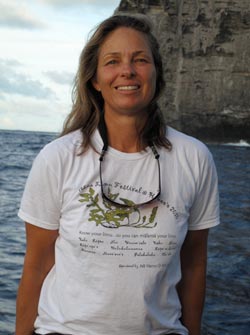
2011 Papahānaumokuākea Intertidal Monitoring Cruise Survey Team Reflections: Emily Fielding – The Nature Conservancy (TNC)
My background and experience is in management planning, partnerships and group agreements, and decision-making. I've been working with groups in coral reef conservation since 2003, and in community-based marine resource conservation since 2007. Participating as a researcher on this cruise allowed me to apply my skills gained from community-based ʻopihi surveys on Maui, to learn new survey methods and skills, and to meet and learn from the expanding network of people across Hawai'i who make up the ʻopihi Partnership.
Led by our principle investigators, Chris Bird and Kēhau Springer, we accomplished almost everything we'd hoped to around six missions: 1) conduct complete intertidal surveys from the highest organism to 10-15 feet below the surface, 2) characterize the marine algae within those surveys, 3) characterize the fishes of the surge zone habitat, 4) collect small numbers of common intertidal invertebrate organisms for genetic analysis, 5) utilize the Native Hawaiian practice of observing and recording occurrences of the environment in the sky, ocean and land to make future connections between weather, lunar and seasonal patterns to biological events, and 6) connect communities conducting 'opihi monitoring to Papahānaumokuākea management activities.
Among the dozens of observations made every day, several things stood out for me. At our first stop, Mokupāpapa, I saw firsthand how the islands and atolls are so small, separated, dry, and rich– I was overcome by the importance of the cultural and natural Hawaiian resources that we have to protect - from the eldest islands in the northwest to the youngest in the southeast. Approaching Mokumanamana from the north at sunrise, I reflected on the briefing from Kekuewa Kikiloi that the entire island is a heiau, a sacred place, in part because of its location on the Tropic of Cancer, the northern most point of the tropics where the sun can be observed directly overhead at the summer and winter solstices – an observation of vital importance for the celestial navigation and calendar keeping of Hawaiian navigators.
One of the most notable outcomes working closely with nine people with different backgrounds was that there were no distractions from cell phones or email. We were all fully present to learn from one another. Community members taught scientists the Hawaiian name and uses of flora and fauna, and we all worked on our Latin names. Methods and gear were utilized in the Monument that will improve our work at home. Personally, I feel gratitude for the opportunity to journey to Papahānaumokuākea and to enrich our relationships and knowledge so we can better manage our resources here at home. Papahānaumokuākea is the largest marine protected area in the most remote archipelago on earth. We are most fortunate to engage, collaborate and support one another.
Click Here for more Survey Team Reflections.
